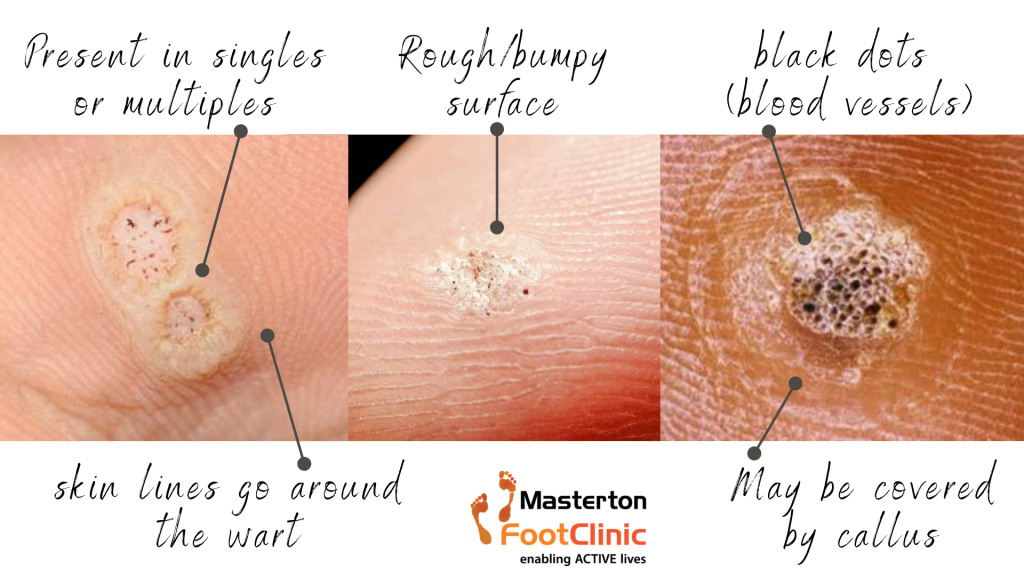04 Aug Why Kids Pick Up Warts On Their Feet At School
As Masterton’s leading podiatry clinic, we see a lot of children and families every week. A big problem we see, especially during the school year, is plantar warts. The term plantar wart simply means:

What exactly is a wart and how does it spread?
A plantar wart is a small, round and rough growth that tends to develop on the bottom of the feet. Warts are caused by a virus – specifically the human papillomavirus (HPV).
Warts spread through direct contact and from sharing surfaces. If you have a break in the skin, like a small cut or graze, or you have a weakened immune system, you are likely to be more susceptible to contracting the virus.
In children, warts are very infectious – especially in areas like school swimming pools, changing rooms for physical education, and anywhere where kids walk around with bare feet.
What does a wart look and feel like?
While some warts can stay small and relatively painless, others can quickly grow and become very painful to walk on. If it’s a wart, you may notice:
- A rough, bumpy surface over the top of the wart
- More pain if you squeeze the wart from side to side, as opposed to pushing down on it
- The skin lines go around the wart instead of through it
- There may be small black dots (dried blood) as warts get their own blood supply
- There may be just one or many warts, and they can differ in size

Parents note:
Warts can look very similar to corns to the untrained eye. Corns are smooth, and have more pain when squeezed down than side to side. They don’t have their own blood supply, the skin lines tend to go through the corn, and they only develop on high-pressure areas like the ball of the foot, the toes, the heel and the sides of the foot. Callus can also develop over both corns and warts to make it even more confusing – meaning that you can’t definitely tell what it is without debriding (removing) the overlying callus. Don’t worry, we treat both of these problems very successfully!
What can I be doing to help my child with their wart at home?
Warts can be tricky because they can grow in size, promote more warts popping up around the original warts (known as satellite warts around the mother wart). The bigger they are, the more difficult they can be to treat, so our first recommendation is to book your appointment to have the wart treated as soon as you notice it. We also recommend:
- Avoiding using any pads for warts that contain acid or other harmful solutions. The acid can’t tell the difference between the wart and the healthy skin around it, meaning that it can ‘eat away’ and damage the healthy surrounding skin. This can be extremely painful for your little one – much more than the pain of the wart itself!
- Encourage your kids to wear shoes and socks at home before the warts are treated to limit the spread to siblings, parents and friends. Wiping down the shower, or using separate non-slip bath mats, can also help limit the spread from the shower
- If walking is painful for your child, try creating an ‘off-loading pad’ by cutting a circle out of a felt pad, with the wart in the cut-out. This means that the surrounding areas will take on the weight and help kids feel better by reducing the pain until the wart is treated
- Give your kids protective (and non-slip!) footwear to wear in public areas like swimming pools
- Check your children’s feet periodically to monitor for any changes – whether it’s a wart or something else!
Treating warts
We treat warts in children (and adults) all year round using a combination of acid, silver nitrate and occlusion. As a virus, warts do not respond to antibiotics, antifungal treatments, antibacterial treatments and the like.
Given that the virus takes over living cells, it’s important to stimulate the immune system to expel the wart tissue. Most children need 4 treatments over 4 weeks and we expect the warts to disappear in 4-8 weeks. We do a review at between 4 and 6 weeks to check the progress and that we’re happy with the outcome.
For adults, we also offer a blunt dissection treatment. This is a minor surgery where we numb the area with anaesthetic so that the procedure is painless, and then the wart is ‘scooped’ out using a small surgical tool. This procedure normally only requires one treatment, the foot fully healed after 2 – 4 weeks, and the procedure has been shown in studies to have a 90% success rate.


